Description
Huge…these gigantic animals are among the largest land mammals on earth. Despite their name, white rhinos are grey in color and exhibit small tufts of black fur on their ears and tails. They have a large hump of muscle on the back of their neck to help manage a massive head from which grow two horns. Unlike the pointed jaw of the black rhino, white rhinos have a wide square mouth for grazing.
Classification
- Class
- Mammalia
- Order
- Perissodactyla
- Family
- Rhinocerotidae
- Genus
- Ceratotherium
- Species
- C. simum simum
- Conservation Status
- Near Threatened
Key Facts
- Height
- 5-6 ft (~150-175 cm)
- Weight
- 5000-8000 lb (~2270-3630 kg)
The IUCN Red List describes Ceratotherium simum simum as Near Threatened, whereas the northern white rhinos (C. s. cottoni) are Critically Endangered. All five rhinoceros species face severe threats from human poachers and organized crime. Due to the extreme value of rhino horn as traditional medicines and aesthetically pleasing artifacts, rhino poaching has come to push some species to the brink of extinction. C. s. simum is the most populous rhino species in the world, estimated at around 20,000 individuals.
Social Life
The imposing size of the white rhino belies what is in actuality a fairly passive animal. They roam large territories either as solitary bulls or in small groups that can grow as large as 14 individuals. Dominant bulls are territorial and mark these areas with dung heaps (called middens), with urine, and by damaging the surrounding land. When confronting another bull, short bouts will include false charges and horn butting. Throughout most of the day, however, these rhinos spend their time either grazing or wallowing in deep mud.
Habitat and Range
White rhinos seem to prefer relatively flat grasslands while sometimes ranging into open woodlands and swamplands. The southern variety of this species is primarily found throughout the clear savannas in southern Africa, especially in South Africa, Namibia, Zimbabwe and Kenya.
Diet
As opposed to the black rhino (Diceros bicornis), white rhinoceros are built to be grazers, mowing through the expansive African grasslands.
Lifespan
Life expectancy in captive and wild white rhinos seems similar in range, from roughly 40-50 years.
Predators
There are no natural predators for this species. Humans are the primary threat.
Reproduction
Sexual maturity: Male: 10-12 years, Female: 5-6 years
Mating Season: Summer and fall
Birth Season: Fall and winter
Gestation: 16-18 months
No. of Young: 1
- Information
-
Description
Huge…these gigantic animals are among the largest land mammals on earth. Despite their name, white rhinos are grey in color and exhibit small tufts of black fur on their ears and tails. They have a large hump of muscle on the back of their neck to help manage a massive head from which grow two horns. Unlike the pointed jaw of the black rhino, white rhinos have a wide square mouth for grazing.
Classification
- Class
- Mammalia
- Order
- Perissodactyla
- Family
- Rhinocerotidae
- Genus
- Ceratotherium
- Species
- C. simum simum
- Conservation Status
- Near Threatened
Key Facts
- Height
- 5-6 ft (~150-175 cm)
- Weight
- 5000-8000 lb (~2270-3630 kg)
- Conservation
The IUCN Red List describes Ceratotherium simum simum as Near Threatened, whereas the northern white rhinos (C. s. cottoni) are Critically Endangered. All five rhinoceros species face severe threats from human poachers and organized crime. Due to the extreme value of rhino horn as traditional medicines and aesthetically pleasing artifacts, rhino poaching has come to push some species to the brink of extinction. C. s. simum is the most populous rhino species in the world, estimated at around 20,000 individuals.
- Lifestyle
Social Life
The imposing size of the white rhino belies what is in actuality a fairly passive animal. They roam large territories either as solitary bulls or in small groups that can grow as large as 14 individuals. Dominant bulls are territorial and mark these areas with dung heaps (called middens), with urine, and by damaging the surrounding land. When confronting another bull, short bouts will include false charges and horn butting. Throughout most of the day, however, these rhinos spend their time either grazing or wallowing in deep mud.Habitat and Range
White rhinos seem to prefer relatively flat grasslands while sometimes ranging into open woodlands and swamplands. The southern variety of this species is primarily found throughout the clear savannas in southern Africa, especially in South Africa, Namibia, Zimbabwe and Kenya.Diet
As opposed to the black rhino (Diceros bicornis), white rhinoceros are built to be grazers, mowing through the expansive African grasslands.Lifespan
Life expectancy in captive and wild white rhinos seems similar in range, from roughly 40-50 years.Predators
There are no natural predators for this species. Humans are the primary threat.Reproduction
Sexual maturity: Male: 10-12 years, Female: 5-6 years
Mating Season: Summer and fall
Birth Season: Fall and winter
Gestation: 16-18 months
No. of Young: 1

